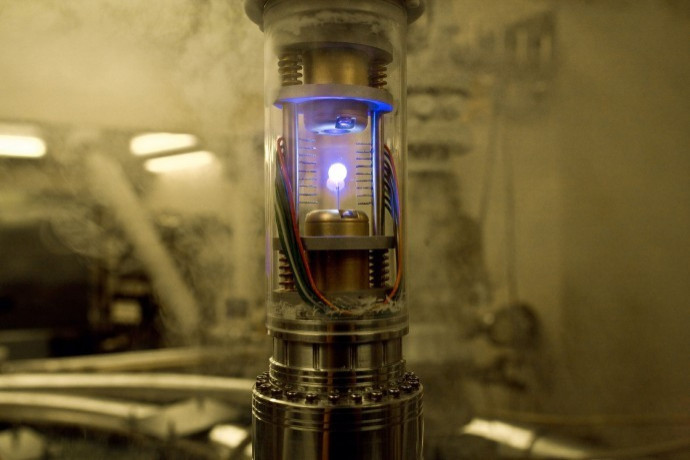Antimatter Trapped For 1000 Seconds, What Next?

Have you read Dan Brown's Angels & Demons book or watched the movie, in which symbologist Robert Langdon tries to stop a legendary secret society Illuminati from destroying Vatican City with the newly discovered power of antimatter stored in a canister?
In the story, scientists have solved one of the most complicated scientific problems: the capture and storage of antimatter. In the real life, capturing atomic antimatter has not yet been achieved.
But now, scientists at European Organization for Nuclear Research (CERN), were successful in trapping antimatter for over 16 minutes, long enough to begin to study their properties in detail.
Now, scientists are planning to start performing measurements on trapped antihydrogen later this year.
Among the various steps, scientists now planning to illuminate the trapped anti-atoms with microwaves, to determine if they absorb exactly the same frequencies (or energies) as their matter cousins.
Scientists are also preparing to measure the influence of gravity on antimatter, which will soon be investigated with antihydrogen.
In particle physics, antimatter is the extension of the concept of the antiparticle to matter, where antimatter is composed of antiparticles in the same way that normal matter is composed of particles.
According to the Dan Brown's book, antimatter is an extremely dangerous substance with immense destructive potential, which is unleashed upon contact with any form of normal matter, and is even comparable to a small nuclear weapon.
It is said that when big bang happened, both matter and antimatter have existed in equal proportion. But, the researchers have been puzzled over the disappearance of antimatter from the universe.
As a result, nature seems to have a slight preference for matter, which allows our universe and everything in it to exist.
The key factor that makes the latest achievement is it helps probing nature's preference for matter by comparing hydrogen atoms with their antimatter counterparts.
We can keep the antihydrogen atoms trapped for 1000 seconds, explained ALPHA spokesperson Jeffrey Hangst of Aarhus University. This is long enough to begin to study them - even with the small number that we can catch so far.
ALPHA is part of a broad programme at CERN's antiproton decelerator (AD) probing the mysteries of one of nature's most elusive substances.
The trapping of antiatoms will allow antihydrogen to be mapped precisely using laser or microwave spectroscopy so that it can be compared to the hydrogen atom, which is among the best-known systems in physics.
Some 300 trapped antiatoms are reported to have been studied in the latest achievement, according to a paper published online by the journal Nature Physics.
Another important consequence of trapping antihydrogen for long periods is that the antiatoms have time to relax into their ground state, which will allow ALPHA to conduct the precision measurements necessary to investigate a symmetry known as CPT.
Symmetries in physics describe how processes look under certain transformations. C, for example, involves swapping the electric charges of the particles involved in the process. P is like looking in the mirror, while T involves reversing the arrow of time.
In the past, American scientist Jeffrey Hangst and his colleagues, from Britain, Brazil, Canada, Israel and the United States, trapped 38 anti-hydrogen atoms for more than 170 milliseconds, according to a paper submitted to the science journal Nature. Following their first success, the team managed to hold the anti-atoms for longer time-spans.
But, now scientists at CERN have trapped antimatter for 1000 seconds.
Trapping antimatter is tricky. When matter and antimatter get too close, they destroy each other, in a kind of explosion, leaving behind the energy which made them. The challenge is cooling the atoms off enough, 272 degrees below zero, so that they are slow enough to be trapped in a magnetic storage device.
An antihydrogen atom is made from a negatively charged antiproton and a positively charged positron, the antimatter counterpart of the electron.
Antimatter--- Not Cheap
The term antimatter was coined by Arthur Schuster in 1898. In his two letters to Nature, Schuster hypothesized antiatoms, whole antimatter solar systems and discussed the possibility of matter and antimatter annihilating each other. The modern theory of antimatter began in 1928, with a paper by physicist Paul Dirac.
Scientists claim antimatter is the costliest material to make. In 2006, Gerald Smith, founder of Positronics Research in Santa Fe, New Mexico, estimated $250 million could produce 10 milligrams of positrons (equivalent to $25 billion per gram). In 1999, NASA estimated that producing one gram of antimatter would cost $62.5 trillion.
The production of antimatter is a costly as only a few antiprotons are produced in reactions in particle accelerators, besides the higher demand for the other uses of particle accelerators.
According to CERN, it has cost a few hundred million Swiss Francs to produce about 1 billionth of a gram (the amount used so far for particle/antiparticle collisions).
NASA Institute for Advanced Concepts-funded studies are exploring whether it might be possible to use magnetic scoops to collect the antimatter that occurs naturally in the Van Allen belt around the Earth. The other possible place to collect them would be from the belts of gas giants like Jupiter.
© Copyright IBTimes 2024. All rights reserved.





















